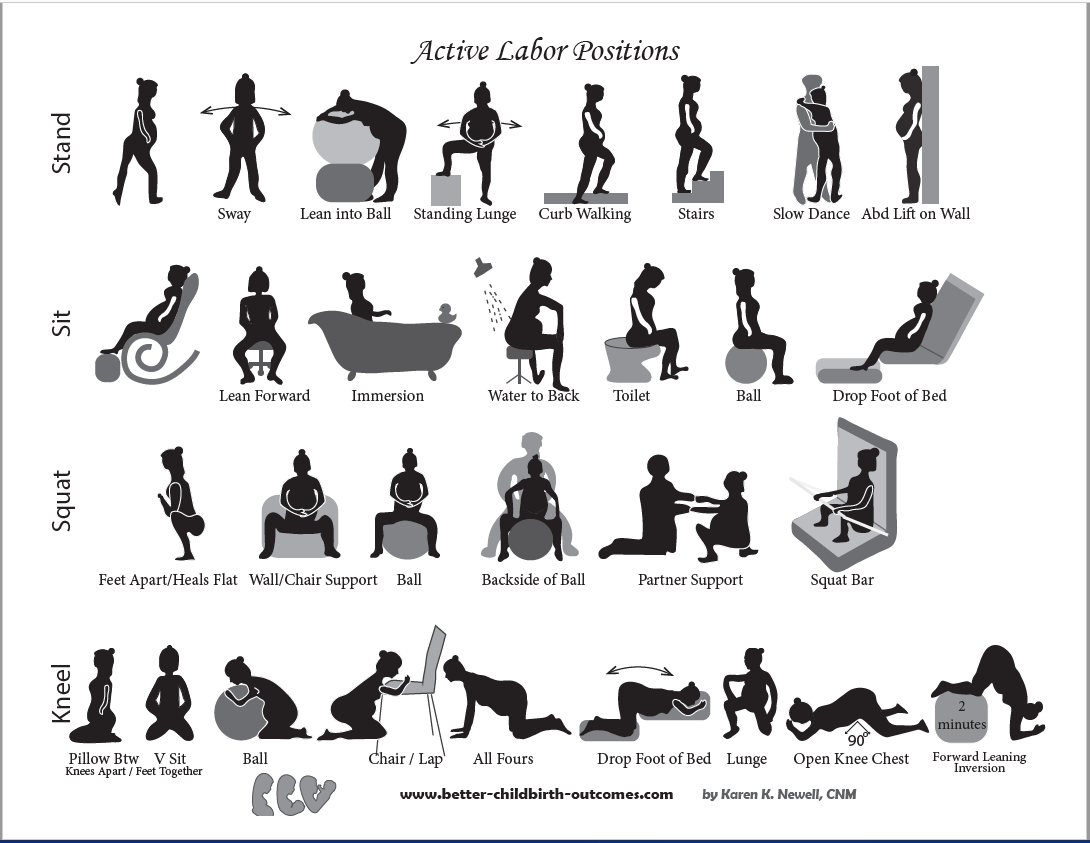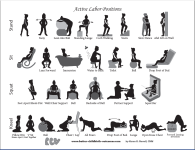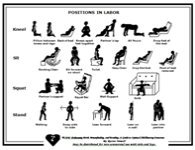
| ||
|
| ||
Positions for ChildbirthUse Active Labor Positions to promote progressUsing active labor positions for childbirth helps the baby descend and the mother's labor progress.
Value of Active Positions for ChildbirthBaby's Descent through the PelvisThe mother's pelvis is the passageway that the baby must navigate in order to be born. Keep in mind that it is an irregular shaped funnel, which has a wider diameter side to side at the pelvic inlet, but at the pelvic outlet the larger diameter is front-to-back. Not only does the baby have to turn to fit the pelvis, but he or she also shifts the head side to side in a motion called synclicism in order to burrow deeper into the pelvis.Therefore, mothers should shift their position to help their babies get into optimal positions to descend through the pelvic funnel. Many of the same positions that are recommended for optimal positioning during pregnancy are also recommended during labor. The ischial tuberosities are the two bones that form the side walls of the pelvic outlet. If you are in a sitting position, you can feel these bones by shifting your weight side to side. When you are sitting upright, your weight is born by these bones. Likewise, when you are standing, your weight is shifted off of the tuberosities. During labor, the pelvic outlet can expand as the tuberosities separate, enlarging the diameter for the baby's head to descend through. This can only be done if the mother is in an open pelvic position. Sitting or lying down, which are closed-pelvic positions, do not allow for pelvic expansion. Standing, squatting, kneeling upright, or kneeling on all fours are open pelvis positions that aid the descent of the baby. Effect on ContractionsThe mother's position can also enhance the force of the uterine contractions. During a contraction, the uterine muscle pulls forward, away from the mother's spine. If the mother is lying on her back, the uterus literally has to contract "uphill." If, on the other hand, her abdomen is leaning forward in a gravity-assisted position, the anterior strength of the contraction is enhanced. This can be accomplished with the mother standing and leaning forward, or kneeling in the all-fours position.Notice that lying on one's back or sitting leaning backward diminishes the effectiveness of these two forces of labor. These positions may be assumed for short periods of time to allow for a pelvic exam or other procedure, but would be counter-productive to stay in for any length of time. During pregnancy, mothers should find and practice a number of open pelvic positions and anterior gravity assisted positions. During labor, this preparation will give her a repertoire of positions to choose from. These contraction-enhancing positions may make her labor more effective, help her to find positions that are most comfortable, and help her remain active. Kneeling PositionsAdvantages of Kneeling in LaborKneeling gives you several advantages during labor.
Different Kneeling PositionsUse a pillow between the upper and lower parts of your legs for comfort. Sit back on the pillow.Lean into the upper part of the hospital bed, if you are confined to bed during a hospitalized labor. Use a V-Sit with your knees apart and feet together. Lean into your partners lap for emotional support, physical comfort, and a back or neck massage. Use the all-fours position to help turn a posterior baby. Drop the foot of the hospital bed lower and lean into the middle section to support your upper body. Lean into a fitness ball and rock back and forth. Sitting Positions for LaborAdvantages of Sitting Upright During LaborSitting is the position we use in Western society most often we are resting without sleep. It is comfortable and familiar.
Different sitting positions for childbirth
Squatting Positions for Childbirth and LaborSquatting is one of the most ideal positions for childbirth. In many cultures, women labor and give birth in a squatting position. More women in Western society are also discovering the benefits of squatting for labor.Advantages of the Squatting Position
How to Squat In LaborThere are two ways to squat in labor: with feet flat on the ground (or bed) or with the heels raised.Squatting with Heels RaisedIn this position the pelvis tilts further forward and the woman may end up arching her back. In addition, the position may cause cramps in the back of her leg.Squatting with Feet FlatThis is harder for some, and some women may not go down into as deep of a squat. But it has the advantage of positioning the pelvis at a better angle for the baby to descend. Legs cramps are much less likely to happen.Ways to Support Yourself in a Squatting PositionIf a woman squats on a regular basis, she may not need any support. Most women who do not usually squat for extended periods find it helpful to have some kind of additional support.
Standing in LaborAdvantages to the standing position in laborWhile few women stand for their entire labor, standing and walking are great assets to a laboring woman.
Common standing positions for childbirth
|
||
|
|
||
|
By Karen Newell Copyright 2003 - 2012 Better Childbirth Outcomes - All Rights Reserved
Camp Hill, Pennsylvania, USA | ||


